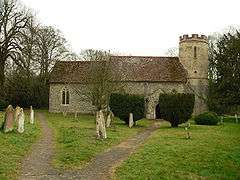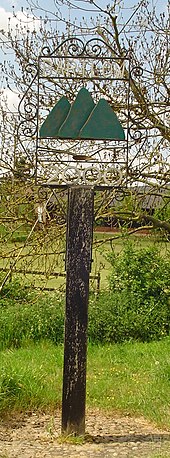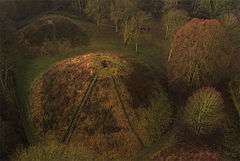Bartlow
Bartlow is a small village and civil parish in the South Cambridgeshire district of Cambridgeshire, England, about 12 miles (19 km) south-east of Cambridge and 7 miles (11 km) west of Haverhill in Suffolk. The River Granta runs through the village.
| Bartlow | |
|---|---|
 Bartlow St. Mary | |
 Bartlow Location within Cambridgeshire | |
| Population | 110 (Including Horseheath.2011 Census)[1] |
| District | |
| Shire county | |
| Region | |
| Country | England |
| Sovereign state | United Kingdom |
| Post town | CAMBRIDGE |
| Postcode district | CB21 |
| Dialling code | 01223 |


History
At 385 acres (156 ha) Bartlow is one of the smallest parishes in Cambridgeshire. Its southern border, which was partially straightened on a few successive occasions to follow the former railway line, divides it from Ashdon parish in Essex. It also has borders with the neighbouring parishes of Castle Camps and Shudy Camps to the east, Horseheath to the north, and Linton to the west.[2]
Though the area has been occupied since Roman times, there is no record of Bartlow itself as a village until 1232, largely because the settlement south of the River Granta with its Roman burial mounds was part of Ashdon Parish nearby in Essex.
Recorded as Berkelawe in 1232, the name "Bartlow" means "mounds or tumuli where birch trees grow".[3]
Bartlow Hills
Bartlow is also home to Bartlow Hills, a Roman tumuli cemetery with three remaining mounds, though only one falls into the parish of Bartlow. Originally, all of the Bartlow Hills were in Essex County and were part of the parish of Ashdon, a village in Essex, (1.5 miles south) when the boundary between Cambridgeshire and Essex ran from Steventon End to the River Granta, then along the Granta westwards to Linton, as shown on Ordnance Survey maps including those dated 1805, 1838 and 1882.
There were originally seven Bartlow mounds. The tallest at 15 metres in height is the largest barrow north of the Alps.[4]
For centuries the mounds were believed to cover the bodies of those killed at the Battle of Ashingdon in 1016, but excavation demonstrated that they are the graves of a wealthy family and date from the 1st or 2nd century AD. Excavations in the 19th century found large wooden chests, decorated vessels in bronze, glass and pottery and an iron folding chair, most of which were lost in a later fire at Bartlow Hall. A small Roman villa, occupied until the late 4th century, was situated north of the mounds and was excavated in 1852.[2][4]
Church
It has long been maintained that the church in Bartlow was built by King Cnut near the site of the Battle of Assandun, but no evidence for a building of that age has been found; another possibility is that the church in question is St Andrew's in Ashingdon, Essex. The present parish church of Bartlow, dedicated to St Mary, consists of a chancel, a nave with north porch, and a circular west tower. The tower is all that remains of what is believed to be the original church and dates from the late-11th or early-12th century. The nave and chancel were built in the 14th century.[2]
Bartlow St. Mary is one of only two existing round-tower churches in Cambridgeshire, the other one being located in Snailwell.[5] There are 3 bells in the tower, all cast by William Chamberlain in 1440 and still hang in their original frame. The 1 & 2's weight is unknown but the tenor (largest) is 9cwt in A. Sadly they are not rung full circle due to the frame being unsafe.
The church is also known for its 15th-century wall-paintings whose fragments include depictions of St Christopher, St Michael weighing souls, and St George's dragon.
Village life
The village has one remaining pub; The Three Hills pub was open by 1847 and is housed in a 17th-century building. Bartlow was listed as having two alehouses in 1682.[2] The Three Hills pub is now open again having been refurbished.
Railways
The railway reached the village in 1865 when the Stour Valley line from Great Shelford to Haverhill opened, running along the southern edge of the parish, with a secondary line on the Saffron Walden Railway branching at Bartlow opening in 1866. Bartlow railway station was open at the railway bridge on Ashdon Road until closing when the Haverhill line was axed in 1967. The station is now a private house called Booking Hall.[2]
See also
References
- "Archived copy". Archived from the original on 28 July 2014. Retrieved 25 July 2014.CS1 maint: archived copy as title (link)
- A History of the County of Cambridge and the Isle of Ely. 6. 1978. pp. 30–36.
- A. D. Mills (2003). "A Dictionary of British Place-Names".
- "Bartlow Hills are a hidden Cambridgeshire treasure". BBC. 20 May 2010.
- Bartlow St. Mary - Round-tower Churches
External links
| Wikimedia Commons has media related to Bartlow. |